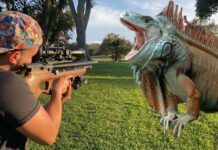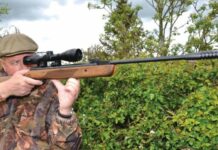Twenty years of chasing cougars with my own dogs have taught me that we in the outdoor media do a lousy job of explaining lion hunting. Even experienced hunters with good dogs finish second much of the time, a fact that too many stories ignore. Even on successful chases, magazine articles and TV programs commonly cut quickly to the tree, the shot, and the dead cat, which makes the process look pretty easy.
Now I invite you to tag along on a real-world lion chase. When we’re done, you can draw your own conclusions.
There are more late-crossing lions in the imagination than in the woods. The term refers to a cat that has crossed the road behind you after you’ve driven up a canyon, searching for a track left the night before. Sign from a late-crosser is a welcome sight because it guarantees a fresh track. Most days, the possibility of spotting tracks made behind you does little more than help you stay awake at the start of a long drive home.
But these tracks were clear, coming down off a bank we’d passed just an hour before.
First spotting them in the headlights, I wrote them off as elk tracks we’d seen on the way in. But something didn’t look right.
I stood on the brakes, and my hunting partner, John, and I jumped out. No doubt about it – we were looking at a tom’s track right on top of our tire tread.
After waiting 20 minutes for legal shooting light – a requirement for turning dogs out in Montana – we walked to the back of the truck for Robbie, John’s bluetick, and Sadie, my walker. As the pair yapped off through the gloom, I fully expected to hear them barking treed before we left the vehicle.
“This one should be about as easy as it gets,” I commented while squirming into my backpack.
Yeah, right.
Although I’d treed cats for others, I hadn’t shot one myself in five years. Now I was the designated hitter, and although I like to downplay the shooting of a cat at the end of a hunt, I confess that the hunt is always more exciting when that role falls to you. As the sound of the chase crossed a creek and disappeared over a ridge, I felt especially eager as we set off in pursuit.
More than a foot of fresh powder snow had fallen that week, and I’d thought about strapping snowshoes to my pack before leaving the truck. But not wanting to pack them through the brush on the mountainside, I decided against it, which seemed like a good idea at the time. Of course, that’s probably what Custer said about his decision at the Little Bighorn.
By the time we’d crossed the first ridge and descended into another creek bottom, the dogs were out of earshot. The track led up a steep mountainside, where deep snow wasn’t a problem under the tree canopy. However, the layer closest to the ground had frozen, and the loose powder on top of it was as slick as grease. We took two steps forward and one step back all the way to the top.
A mile down the ridge, the trail took a confusing turn as we ran into a chaotic jumble of tracks going in different directions. We did find bounding lion tracks where the dogs had jumped the cat, but rocky cliffs below made it impossible to see what had gone where, and blowing snow blurred dog and cat tracks. To complete the confusion, John found lion prints disappearing back into the timber where we’d just come out – with no dog tracks on top of them.
One possible explanation for such confusion is multiple lions. Despite inherently low population densities, cats have a way of finding each other in those lonely hills. It was also possible that a lion kill lay nearby. In any case, fresh lion tracks would do us no good without dogs. So we hunkered down in the timber and waited for them to show up.
But they didn’t. As much as we hated the thought of losing the elevation we had gained, we split up and picked our way down the far hillside, trying to work out the muddle. The blowing snow wasn’t helping, but at one point I was sure I had running lion tracks with dog tracks on top of them. At the bottom, John found the same going on up the next mountain. Although something didn’t feel right, we decided to follow the track.
The second mountainside wasn’t as demanding as the one we’d climbed earlier until we approached the top, where we encountered a maze of steep, rocky cliffs. Ascending one vertical chimney proved nearly impossible without technical climbing gear, but somehow we powered our way up through it.
Another mile down this ridge we encountered more bounding cat tracks; the dogs had caught up with the lion again. Then we entered an area of blowing snow and got separated as we tried to work out the track. By the time I finally picked it up again down in the timber, John’s boot tracks were on top of it, but we were out of earshot. We wouldn’t see each other again for hours.
The chase led back downhill in the direction from which we’d just come. If the dogs had a cat treed on the hillside, I should have been able to hear them. The track I was following led right back toward the spot where we’d first got confused.
A sinking feeling hit me in the pit of my stomach as I finally deduced what had happened. By the time we were waiting on the last ridge, the cat and dogs had already run the loop we’d just spent three bruising hours following! The lone track sneaking back across the ridge had been our cat, and the dogs were lost somewhere on the mountainside.
Back at the creek bottom we’d crossed earlier, I paused to take stock. Our lion hunt was over. I’d been on the trail for seven hours. The dogs were lost, the weather was deteriorating, and limited light remained. It was time to consider priorities. The first order of business was planning my route out of the woods. The dogs came second. I didn’t know where John was, but he would take care of himself.
The wisest choice in these situations is usually to return the way you came, but I knew the creek bottom eventually led to the road. Even though that route was longer, it would save me a long climb.
Then the faint sound of a lost dog’s barking rose above the wind down the creek. That finalized my decision, and after slogging through a mile of snow, I was overjoyed to find dog tracks. Then Robbie and Sadie appeared from the trees. The team was nearly reassembled. All I had to do was get us home, which should have been easy, given the open terrain along the bottom.
However, snow had blown, drifted, and settled on the open ground. Worse yet, the crusted snow was almost, but not quite, firm enough to support my weight. The conditions were perfect for snowshoes – but you know where mine were.
I will admit to being one tired pup by the time I reached the side road that would eventually lead back to the vehicle. Even the well-conditioned hounds were dragging, and we were still two miles from the truck.
Then the most welcome sight imaginable appeared – John had taken the shorter route out, and using the ESP that hunting partners develop after years together in the field, he had figured out exactly where I’d be. The sight of both hounds was probably as welcome to him as the warm truck was to me.
The cat may have won that chess match, but we knew we’d been on an honest lion hunt, with no help from snow machines or radio tracking collars. And that’s the simple tale of a lion chase that was supposed to be as easy as it gets.
It’s a year later now, and the new lion season has just begun. On opening day, the alternator on my truck went out in the middle of nowhere right after we spotted the first cat track of the season. Rather than risk more confusion, John and Scott, a friend visiting from Alaska, stayed with the dead vehicle while I spent eight hours hiking out of the woods to a telephone from which I could call my wife Lori to come rescue us. My 60-year-old legs were already aching, and I had yet to turn Sadie out on a cat.
But yesterday’s events perfectly illustrate the other side of lion hunting. We crossed a smoking fresh tom track right at sunrise, and the dogs were barking at the tree by the time we’d slipped on our packs. Scott drove the arrow home with his recurve, and less than an hour later we were back at my resurrected truck with Scott’s first lion.
“You’re a lucky hunter,” I told Scott as we loaded the dogs back into the vehicle. “That chase was about as easy as they get.”
“I know,” he replied. “I almost wish it had been harder.”
“Are you sure?” I asked with a laugh, and then we were bouncing back down the road looking for the next set of tracks.
Adventuresome Bowman Don Thomas lives in rural Montana with his bowhunting wife, Lori. Don’s 15 outdoor books are available through www.donthomasbooks.com.











































